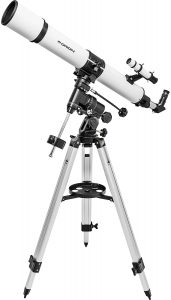The Gskyer 90mm AZ90600 is my favorite Gskyer telescope model. It is just the right combination of stability, lightweight, ease of use, and capabilities for anyone with a sweet tooth for astronomy. Replace the diagonal and eyepieces and this scope could sit right beside much higher-priced models used by experienced amateur astronomers.
More information on how to set this telescope up and use it can be found on my manuals page.
Table of Contents
Telescope Specifications
Specs here
| Type of telescope | Newtonian reflector |
 Objective aperture Objective aperture | 90mm (3.54″) |
 Focal length Focal length | 600mm(f/6.7) |
 Type of mount Type of mount | Altitude Azimuth |
 Eyepiece magnification Eyepiece magnification | 25mm(24X), 10mm(60X), & 5mm(120X) |
 Maximum magnification Maximum magnification | 225X |
 Tripod Tripod | Adjustable 65cm aluminum tripod |
Gskyer AZ90600 telescope review
here
Review Conclusions
here
Videos
here
Best Gskyer Telescope Alternatives
There are some excellent options if you can not get the Gskyer AZ90600 90mm refractor, or if you want something a little different. For whatever reason, here are some of my favorites:
Orion Observer 90mm EQ (quality)

Long one of my favorite beginner telescopes, Orion has a little bit of magic with their 90mm telescopes, including their new Orion Observer 90mm Equatorial Refractor Telescope.
For about $60 more than the Gskyer 90mm you get a better scope, a better mount that is also an EQ instead of the alt/az from Gskyer, and far better Plossl eyepieces.
This telescope is so good that even though I have setups costing over $4k, I still own not one, but two models of this telescope. It is just so easy, fun, and reliable that I can not bear to sell them. I have one 2021 model, and one from the 1990s, and love to use them both.
If the world could only have one telescope for beginners in astronomy, I hope this would be the one.
Celestron StarSense Explorer DX 100AZ (ease of use)

If you want to just easily point and see objects in the night sky, it is hard to go wrong with the Popular Science StarSense Explorer DX 100AZ refractor telescope (by Celestron).
Not only do you get a larger aperture, higher quality eyepieces, and a red dot finder, but you get their StarSense technology which puts a smartphone dock on the side of the telescope. This ingenious dock runs the StarSense software and shows you right where to point your telescope to get objects right in the middle of the eyepiece.
Yes, this telescope is about $75 more than the Gskyer, but it will more than make up for that increase in price by letting you see far more objects, easily.